Varutharacha sambar recipe with step by step pics. Kerala varutharacha sambar is a delicious variety of sambar made with mix veggies, lentils, roasted spices and coconut. A vegan recipe.
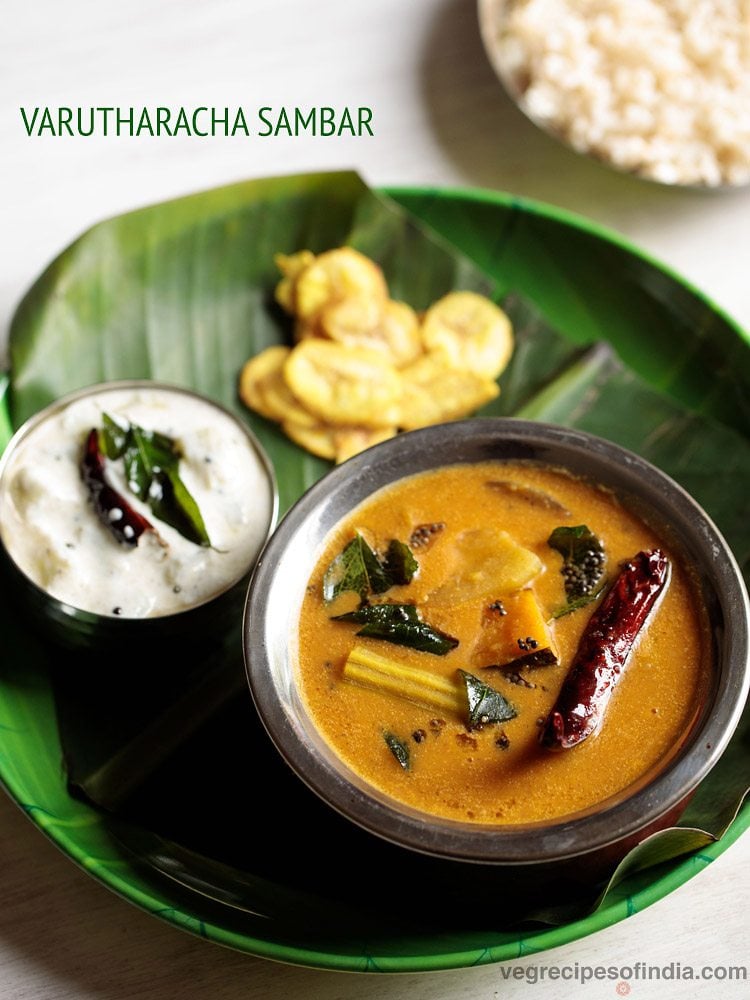
Varutharacha Sambar is a typical spicy and tangy sambar. What makes it distinct than its other South Indian counterparts is the roasted coconut paste in it. Thus, the roasted coconut is one of the highlights of this particular sambar.
This roasting of coconut for making the coconut-spice paste also makes the Varutharacha Sambar taste different than the regular variety of sambar that is made with sambar powder.
In addition to the fresh grated coconut, other ingredients for this paste are chana dal, urad dal, coriander seeds, fenugreek seeds and dried red chilies. These are roasted in coconut oil for that authentic feel and flavor.
Varutharacha sambar is served in the onam sadya and I thought of sharing my method. I do make this Kerala varutharacha sambar once in a while. I have shared another version before which is my mom’s recipe and even that one is delicious and comfort food for me. Recipe is here – Kerala sambar.
Of course The type of veggies you add in sambar does contribute to its overall flavors and taste. I prefer to add pumpkin, drumsticks, yam, okra, brinjal, yellow cucumber and white gourd. Though you can add whatever mix veggies you have.
The vegetables that can be added in a sambar are:
- Carrots
- Snake gourd
- Ash gourd
- Pumpkin
- Drumsticks
- Bottle gourd
- Okra
- Plantain
- Elephant foot yam
- Colocasia
- Potatoes
- Ivy gourds
- Brinjal
- Pearl onions/shallots
- Tomatoes
- Yellow cucumber
- Radish
Making varutharacha sambar takes some time as there is some preparation work. So you can first chop the veggies and keep them ready.
Next you can cook dal and then cook the veggies. When the veggies are cooking, make the roasted coconut sambar masala. I have added pearl onions in the sambar, but you can skip them for a no onion version. Even tomatoes can be skipped.
You can even use three pan which fit each other and cook dal, veggies and rice together in a 5 to 6 litre pressure cooker. To check this method of pressure cooking you can check this recipe post – Poricha kuzhambu.
Varutharacha sambar tastes best with steamed rice. Though at times I have even served it with idli, dosa and uttapam.
How to make Varutharacha Sambar
Pressure cooking dal
1. Rinse ⅓ cup tuvar dal (pigeon pea lentils) a couple of times in water. Add the lentils in a pressure cooker. Add ¼ teaspoon turmeric powder.
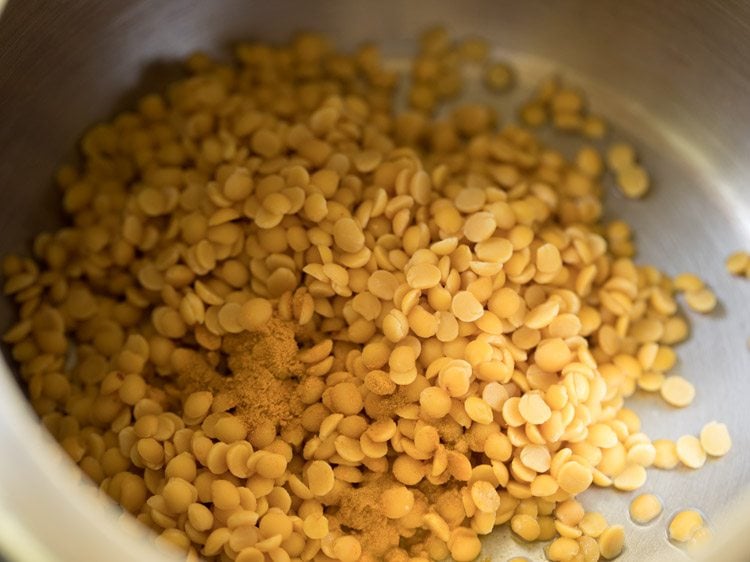
2. Add 1.25 cups water.
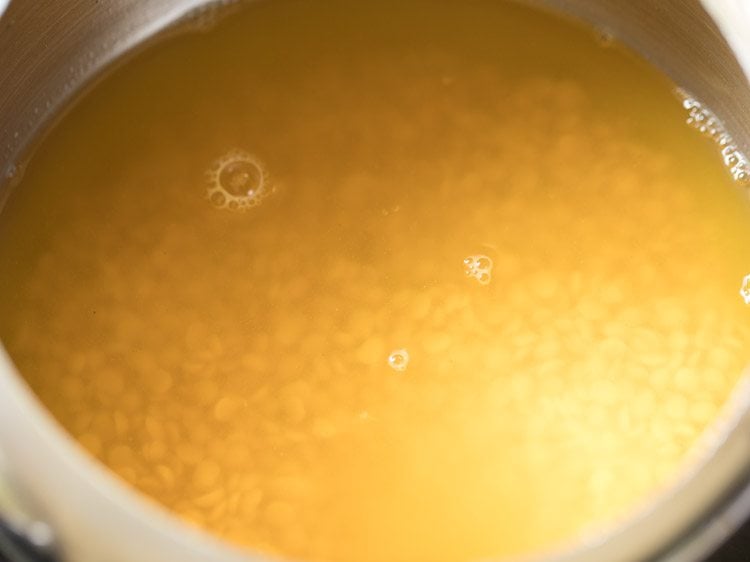
3. Cover and pressure cook on a medium heat for 7 to 8 whistles or for 10 to 11 minutes till the dal becomes mushy and soft.
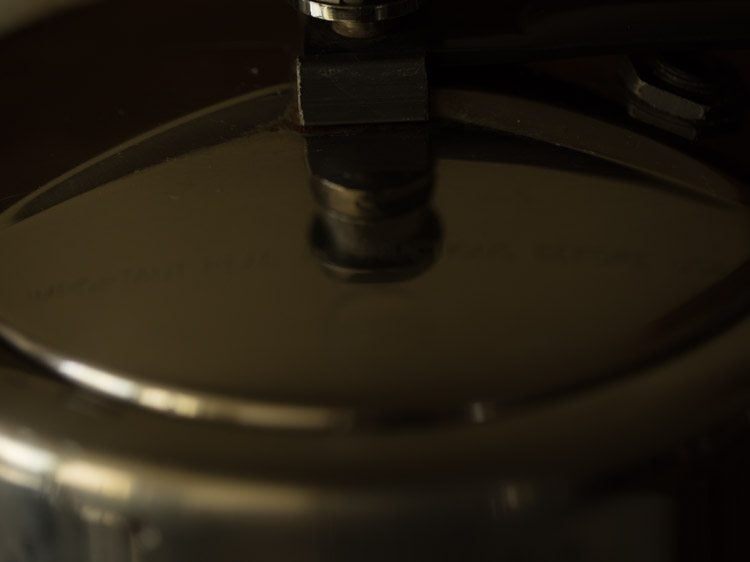
4. When the pressure settles down, then only open the lid.
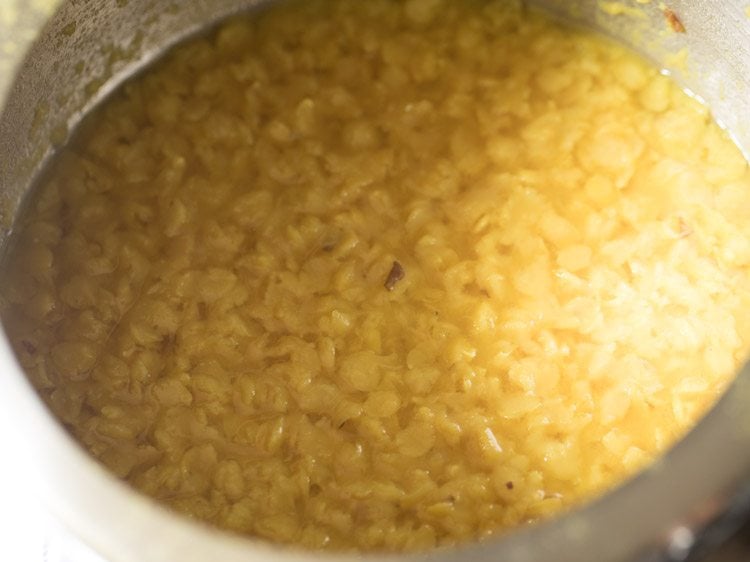
5. Mash the dal well with a spoon. Cover and keep dal aside.
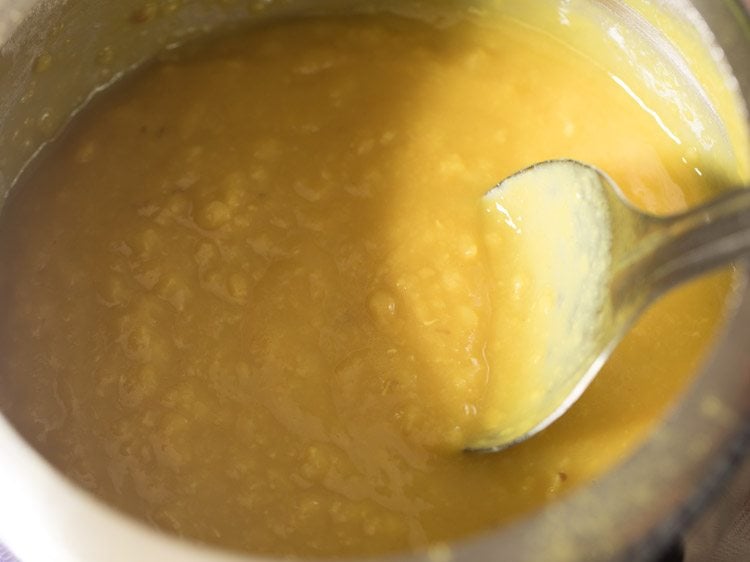
Making tamarind pulp
6. Meanwhile when the dal is cooking, soak ½ tablespoon tightly packed tamarind in ⅓ cup hot water. Cover and keep aside for 20 to 30 minutes.
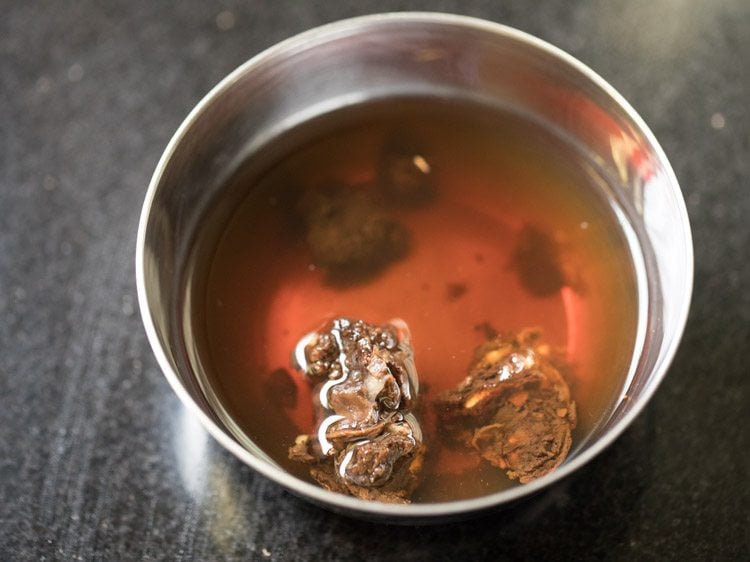
7. Later squeeze the pulp from the tamarind with your fingers and add in the bowl. Keep the tamarind pulp aside.
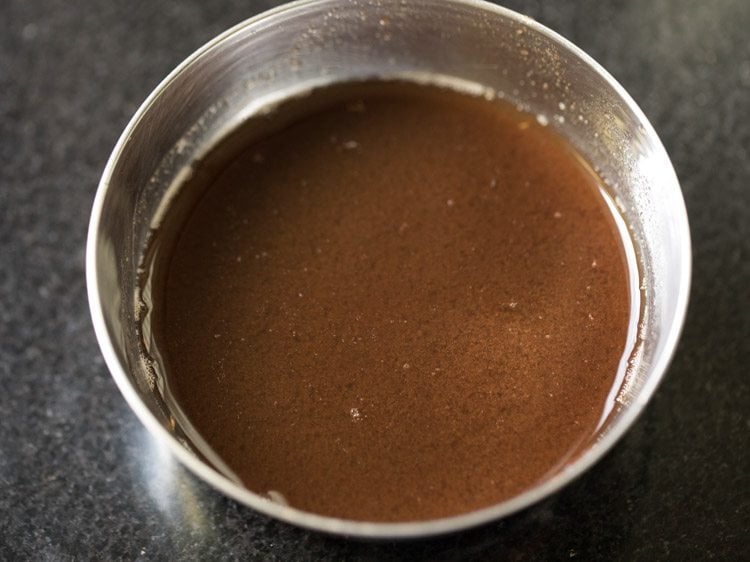
Cooking veggies for varutharacha sambar
8. Rinse, peel and chop all the veggies in slightly large pieces. I have used 1 cup chopped ash gourd, 1 cup chopped brinjal, 1 cup chopped pumpkin, ½ cup chopped drumsticks, ½ cup chopped snake gourd and ¼ cup chopped french beans. You can use 4 to 4.5 cups of chopped mix veggies.
Soak brinjals in water. If using plantains, yam or colocasia, then soak them too in salted water. You can chop the veggies and keep them ready ahead of cooking everything. Discard the seeds and pith from ash gourd, pumpkin and snake gourd.
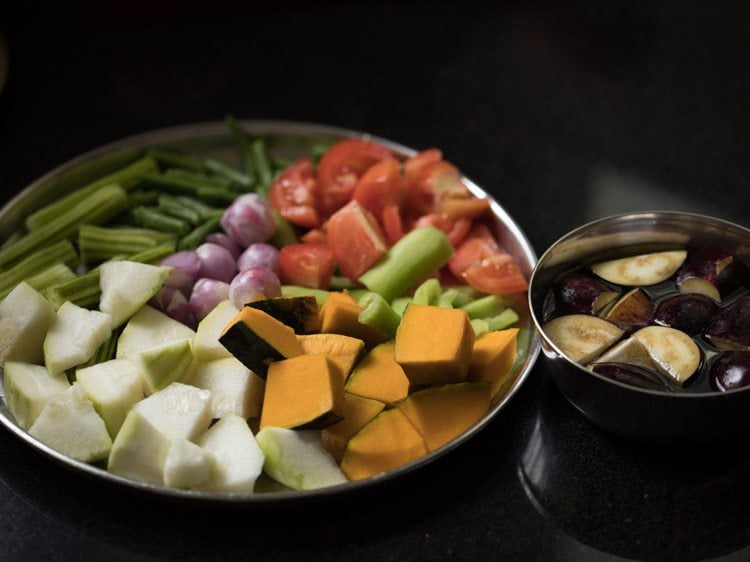
9. Heat 1 tablespoon of coconut oil in a pan.
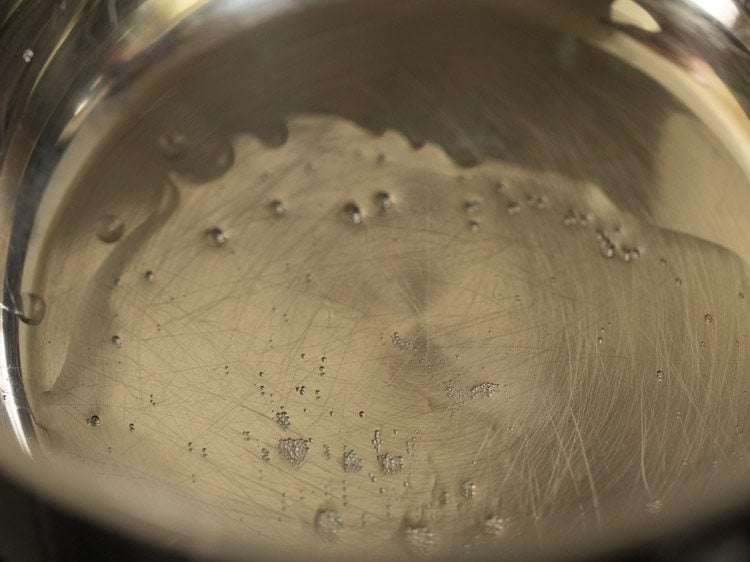
10. Add 7 to 8 pearl onions or shallots. Onions can be given a skip.
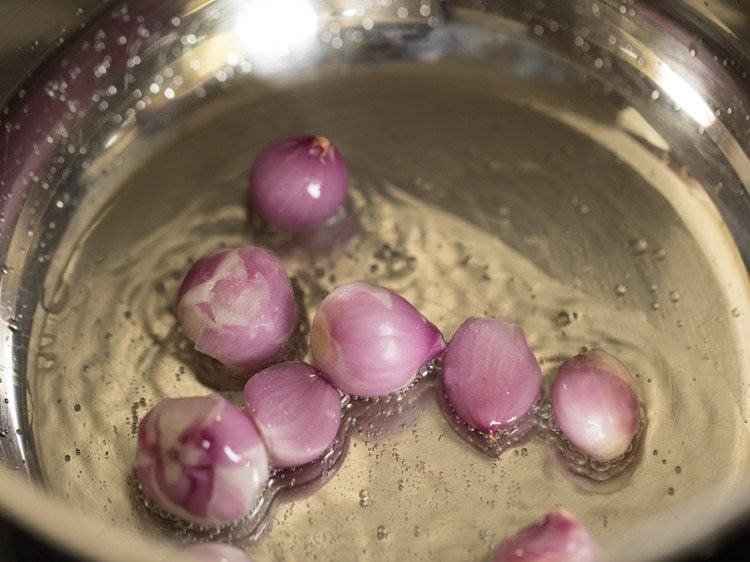
11. Sauté for 1 to 2 minutes on a low to medium heat.
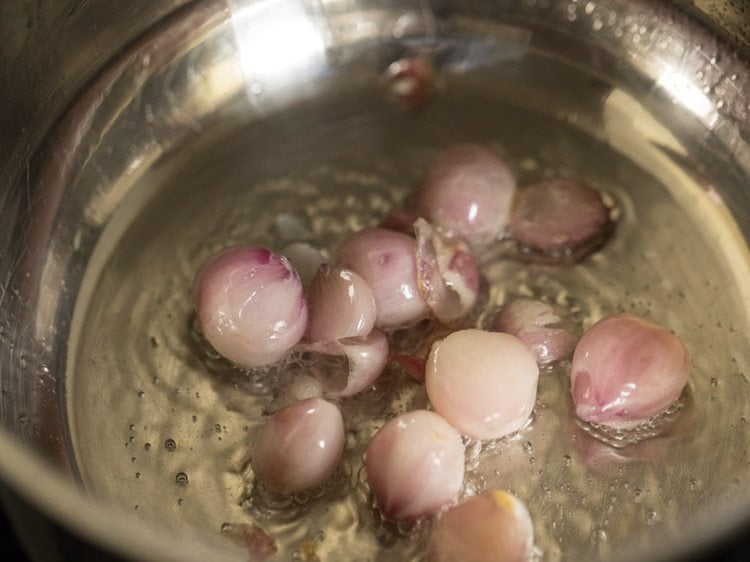
12. Then add ½ cup diced tomatoes. Tomatoes also can be skipped if you want.
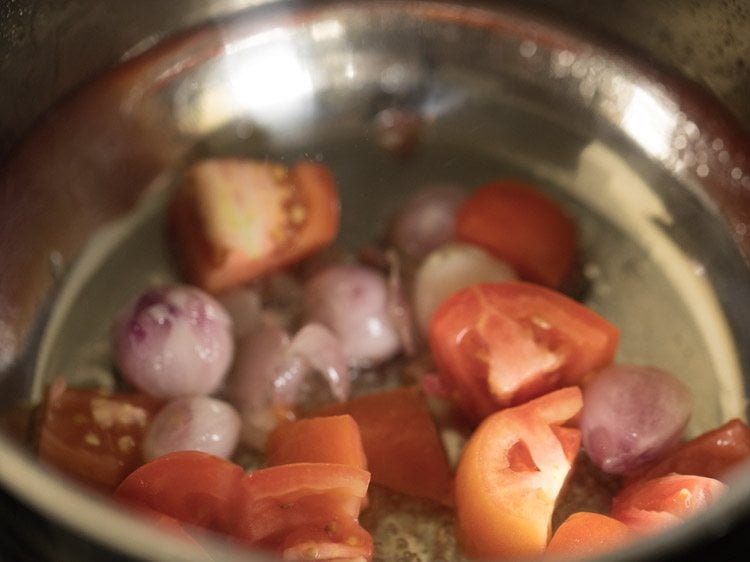
13. Sauté tomatoes for 1 minute.
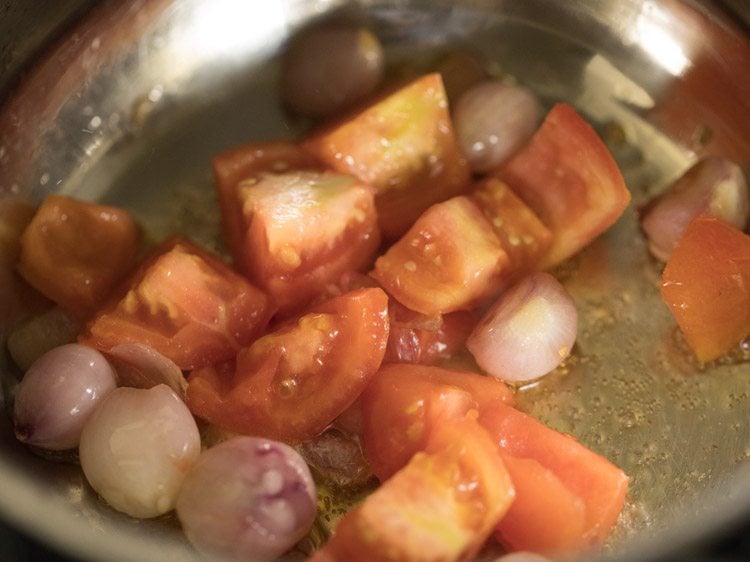
14. Now add the chopped veggies.
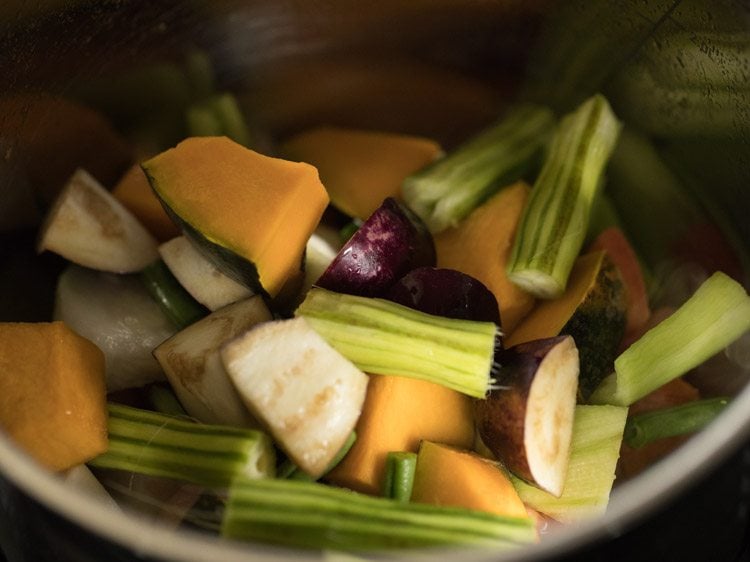
15. Sauté for a minute.
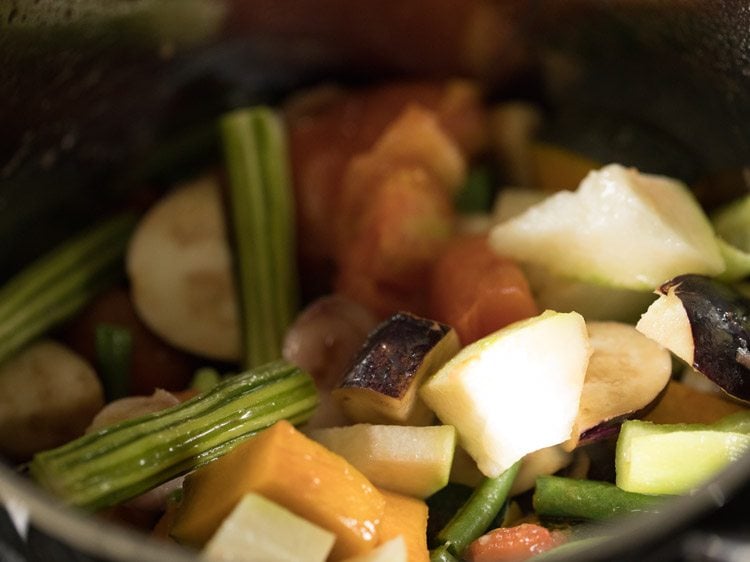
16. Then add ¼ teaspoon turmeric powder.
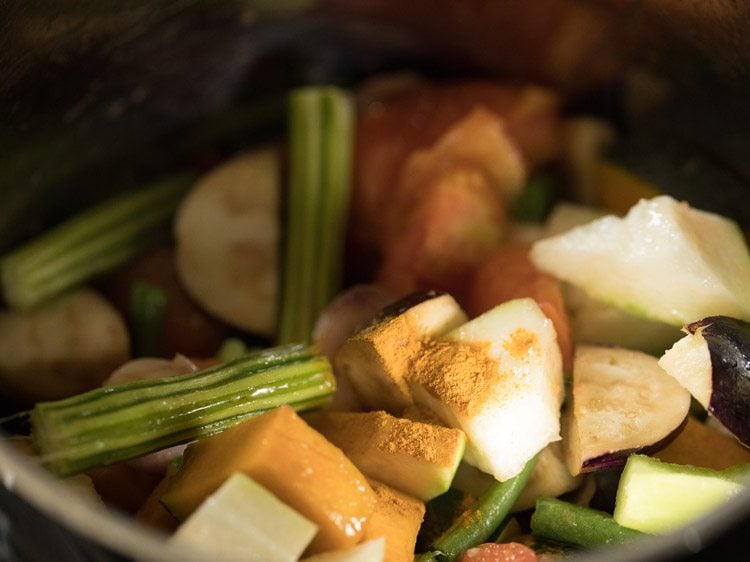
17. Stir and mix well.
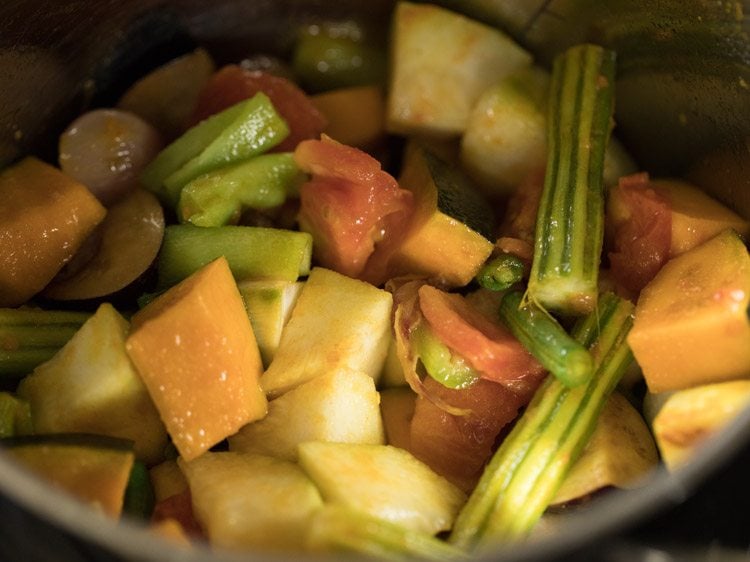
18. Pour 2 cups water and mix well.
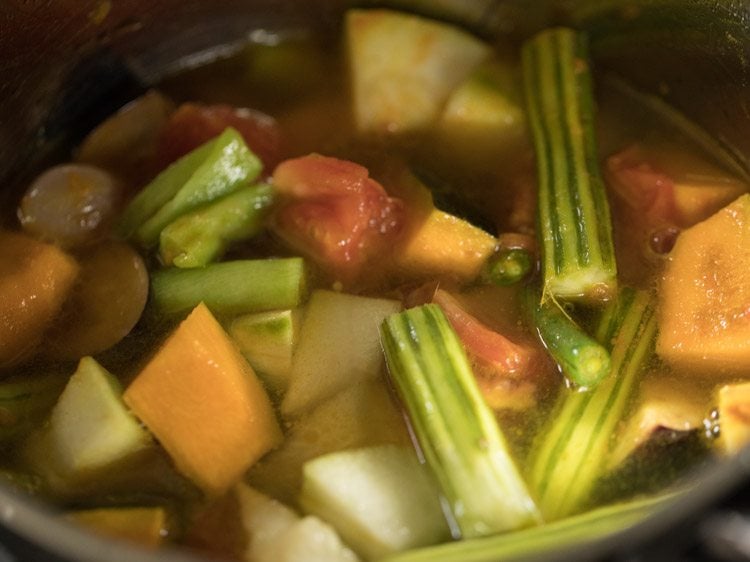
19. Add salt as required and mix again.
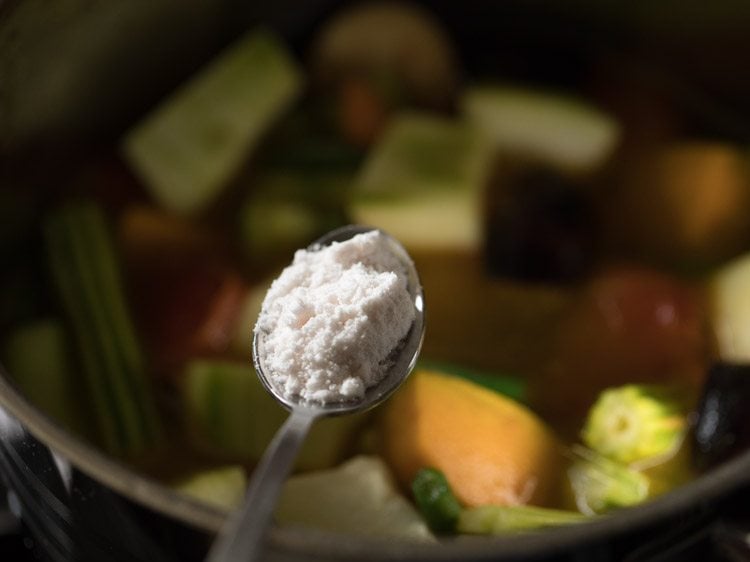
20. Cover and cook veggies till they are tender and done. Do not overcook them.
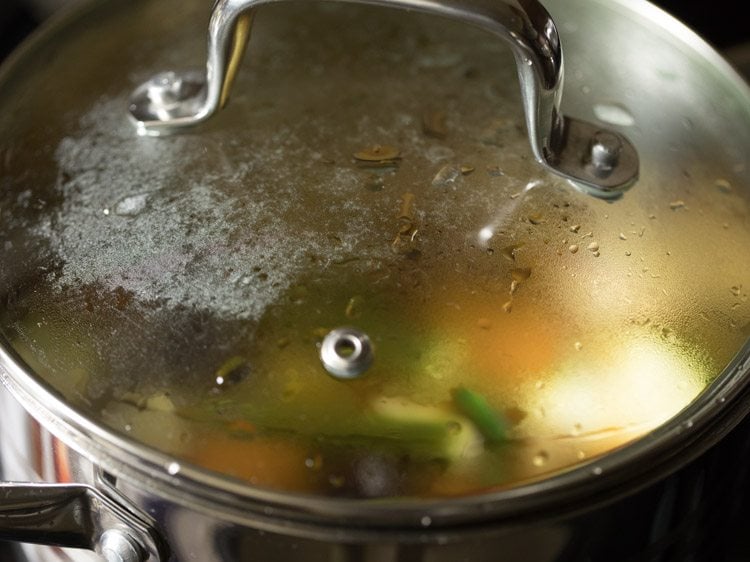
21. Do check when the veggies are cooking. Cooking veggies on a medium-low heat takes about 20 to 25 minutes.
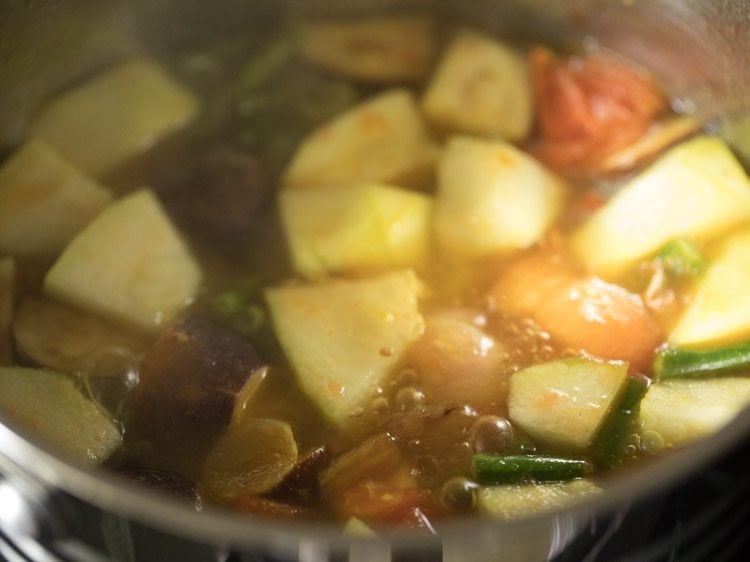
Making varutharacha sambar masala
22. When the veggies are cooking, you can make the Varutharacha sambar masala. for this in a small frying pan, heat ½ tablespoon coconut oil. Keep the heat to a low and add 1 teaspoon chana dal and ½ teaspoon urad dal.
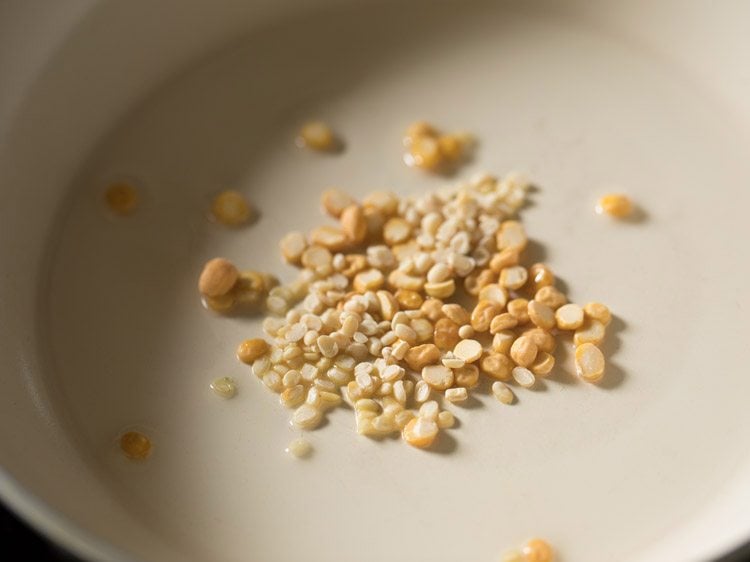
23. Stirring often fry them till they become golden.
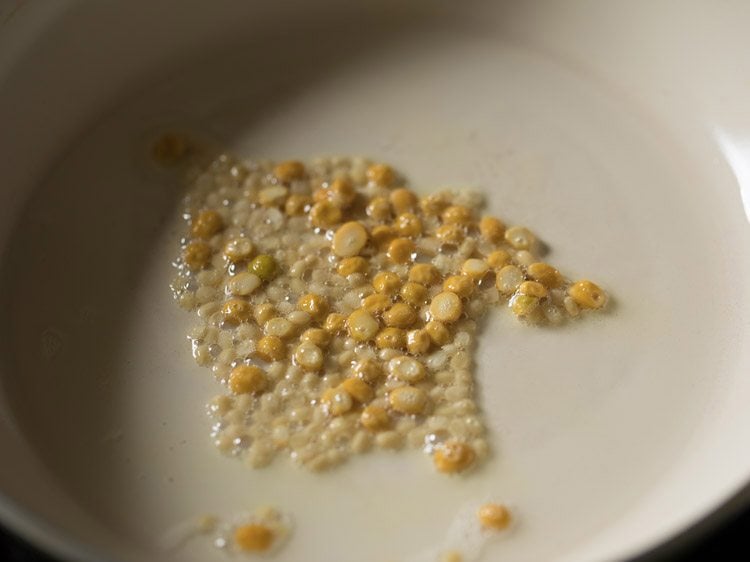
24. Do stir often for uniform cooking of the dals.
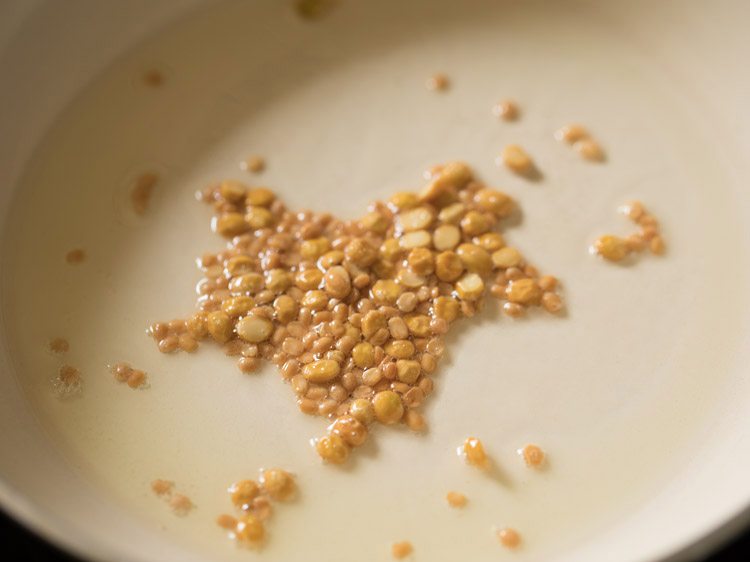
25. When the dals have become golden, add 1 tablespoon coriander seeds and mix well.
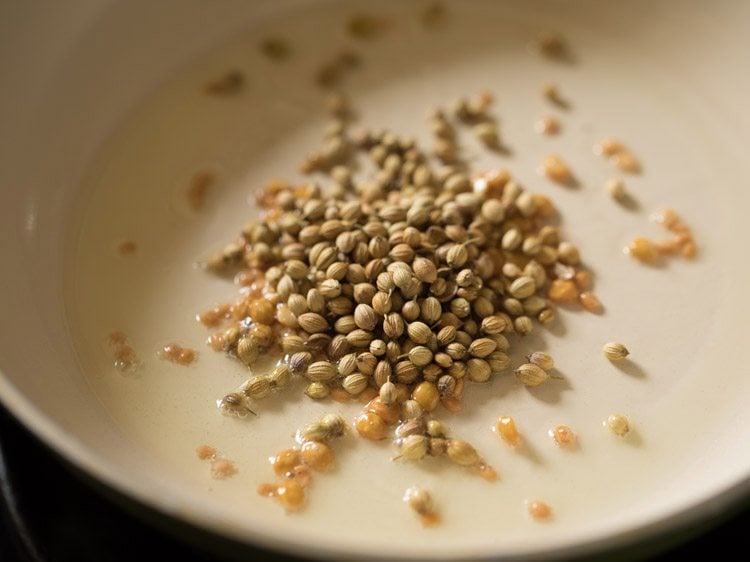
26. Next add 4 to 5 dry red chilies (broken and seeds removed).
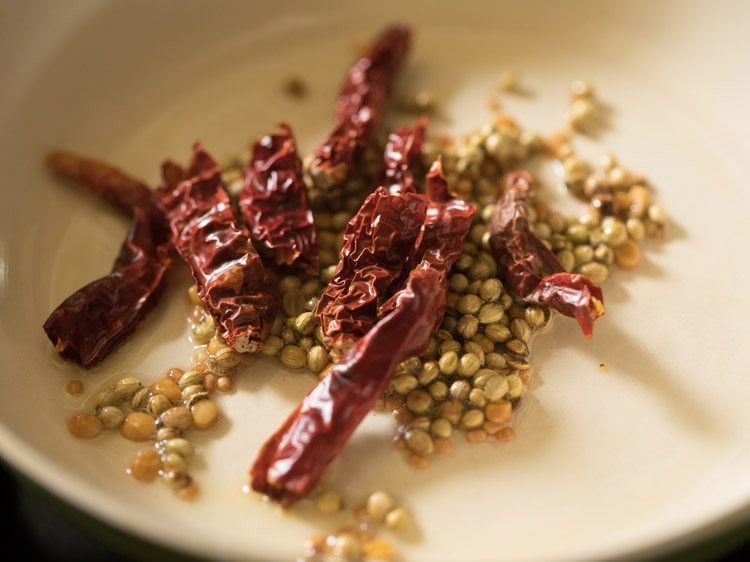
27. Mix well.
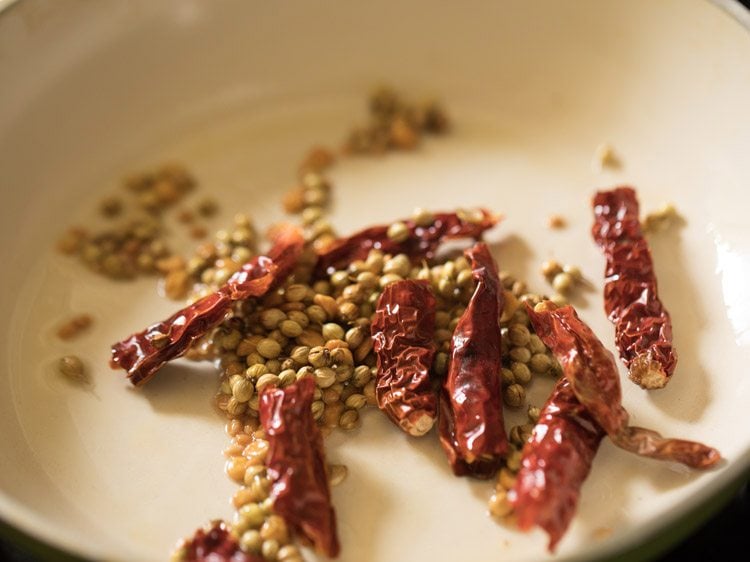
28. Now add ¼ teaspoon methi seeds.
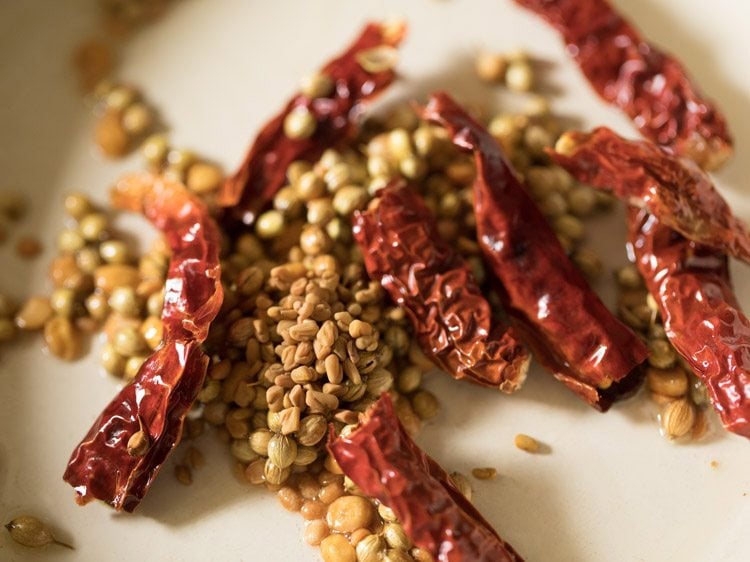
29. And again mix.
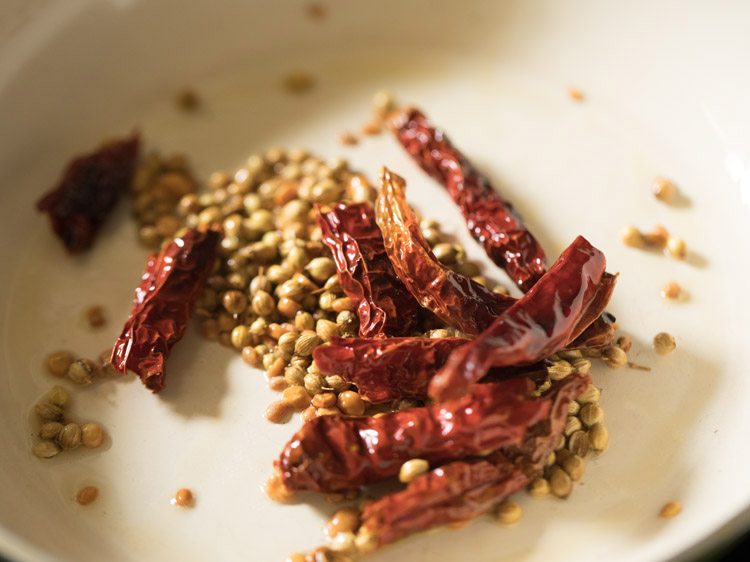
30. Then add ½ cup fresh grated coconut.
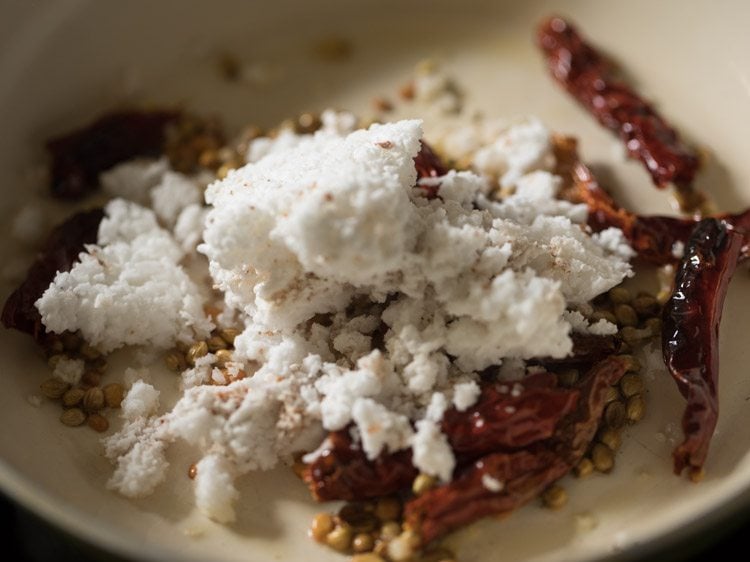
31. Mix again.
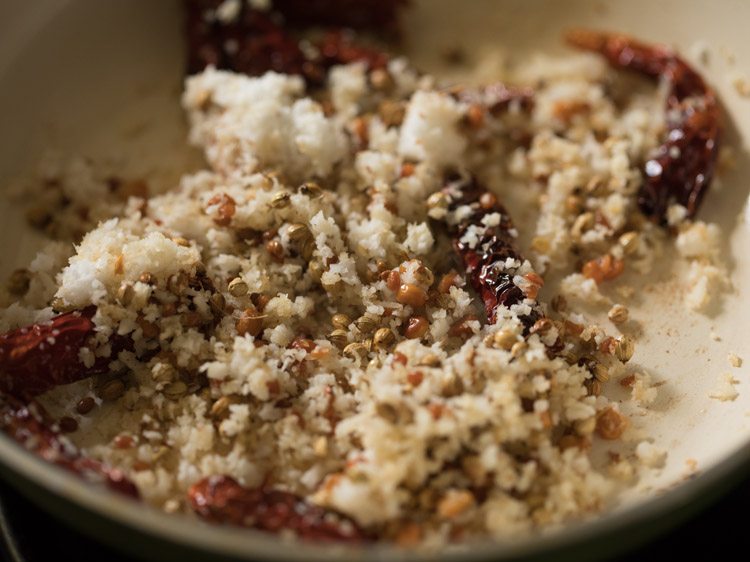
32. Stirring non-stop roast the coconut till it becomes golden. Do not burn or over brown coconut. Once the coconut has become golden, remove the pan from fire and keep it down on the kitchen countertop. Stir so that the heat is distributed and the coconut does not roast more.
Let this sambar masala mixture become warm or cool down. If the veggies are cooked by this time, then switch off the flame and keep the veggies aside.
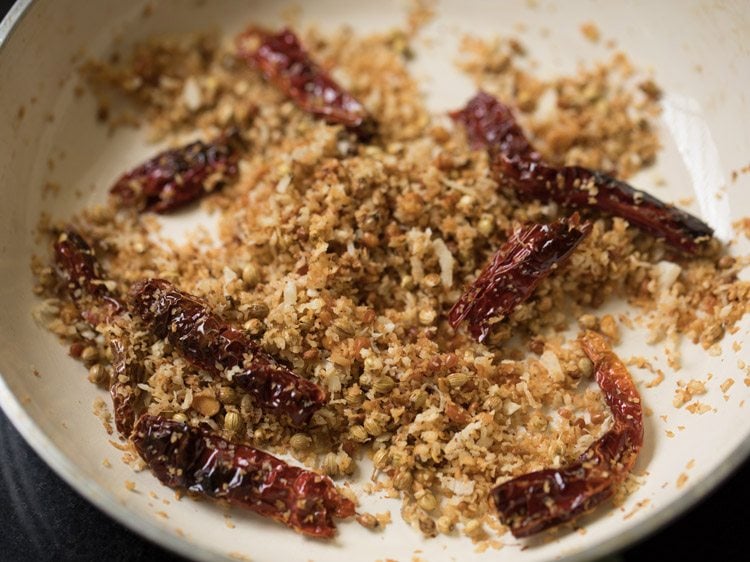
33. Add the roasted coconut+spices in a grinder jar.
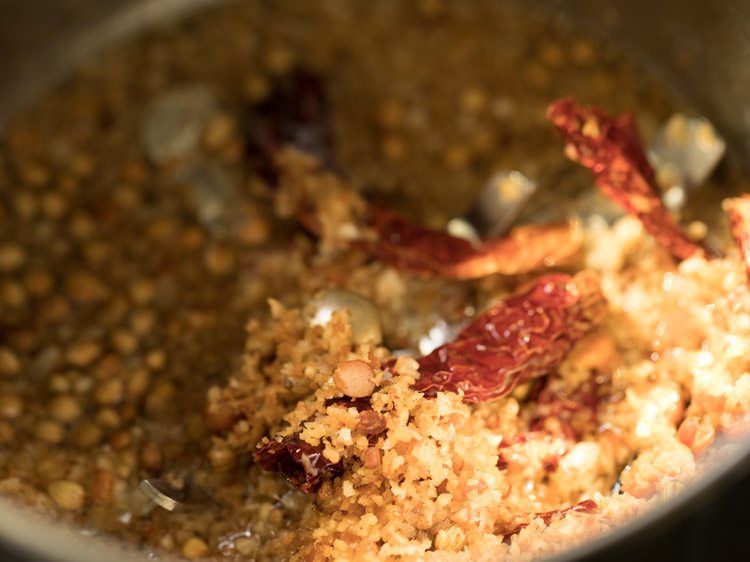
34. Add ½ cup water and grind to a smooth paste.
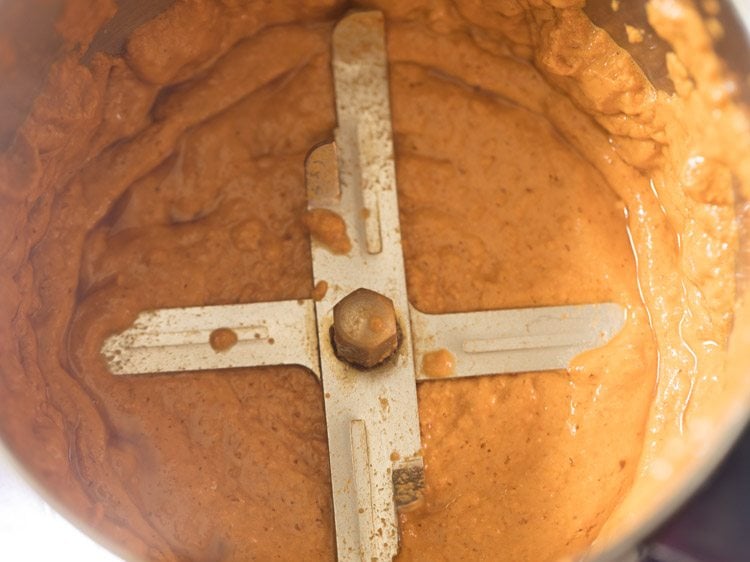
Making varutharacha sambar
35. The veggies will be done by now. Check them if they are cooked and softened.
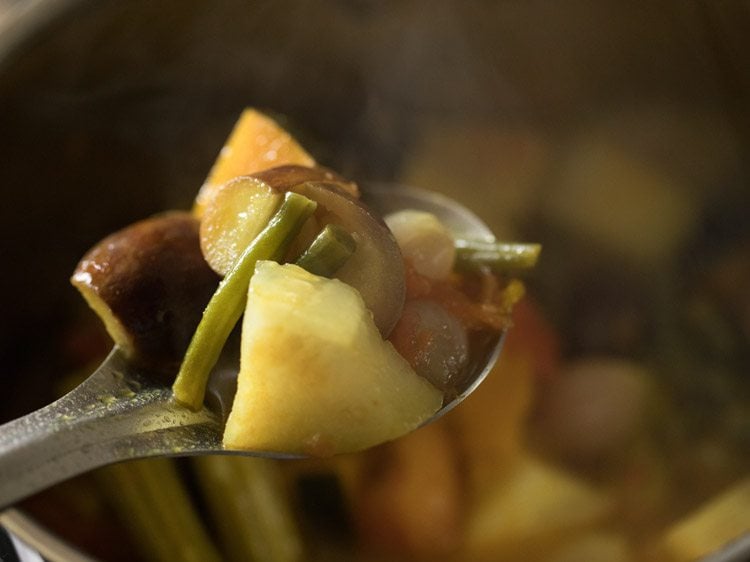
36. Now first add the tamarind pulp to the veggies.
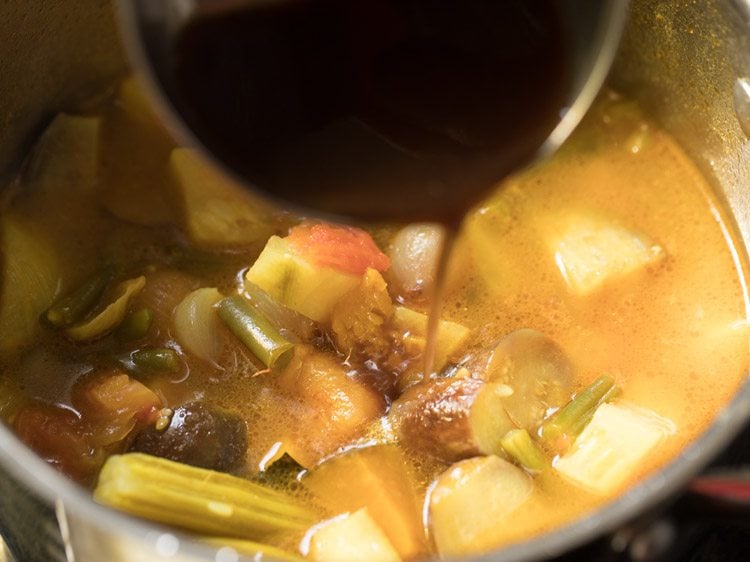
37. Then add the mashed dal.
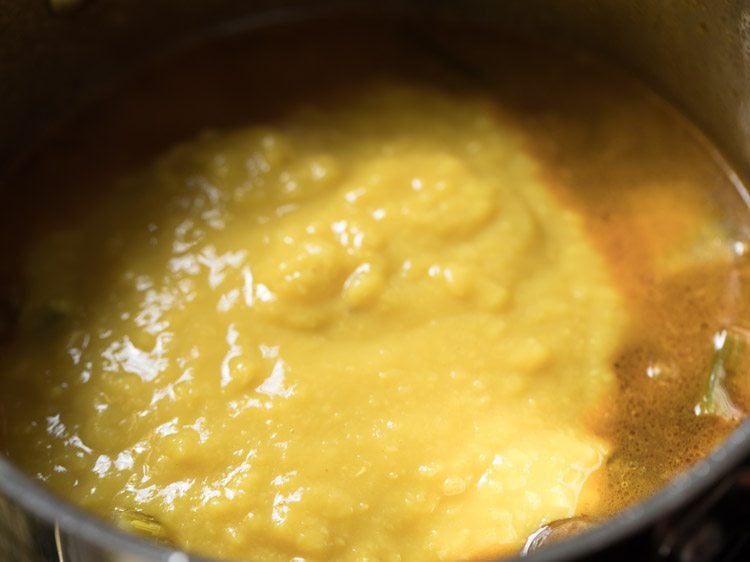
38. Next add the sambar masala paste.
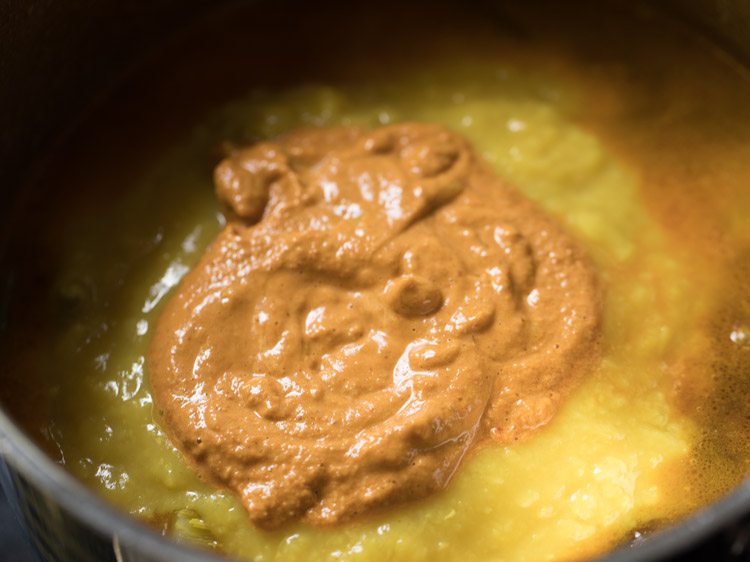
39. Mix very well.
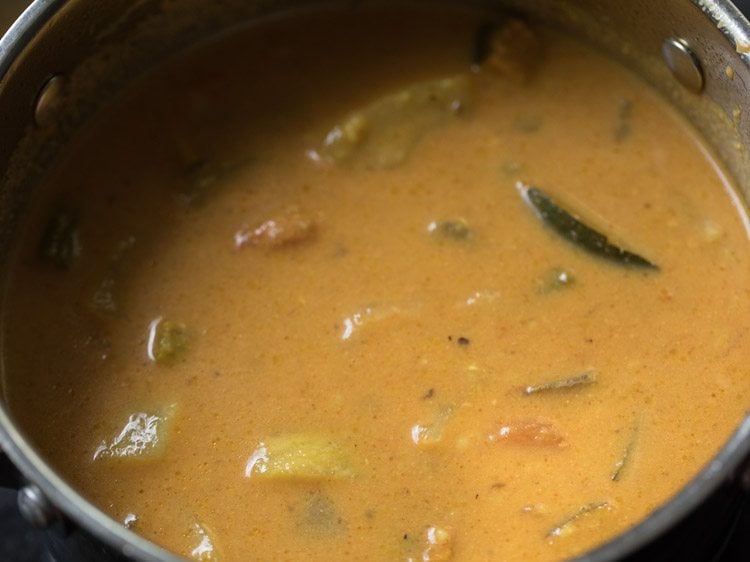
40. Keep the pan on a low to medium heat. Add 2 to 3 tablespoons water in the grinder jar and shake and swirl it so that the masala stuck at the sides and bottom of the jar gets mixed with the water. Then add this water in the pan.
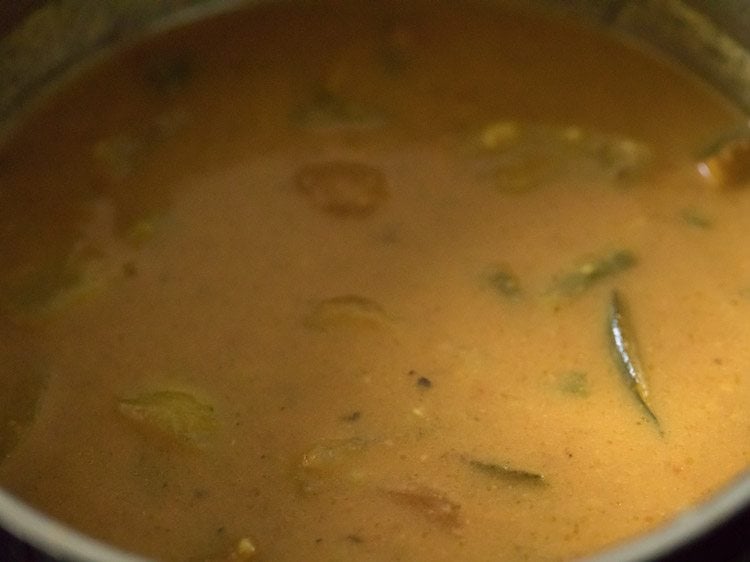
41. Simmer the sambar till it comes to a boil. You will see some froth on the top and at this stage, you can switch off the heat. Do not overcook. Do stir at intervals. Cover and keep aside. Check the taste and add more salt if required.
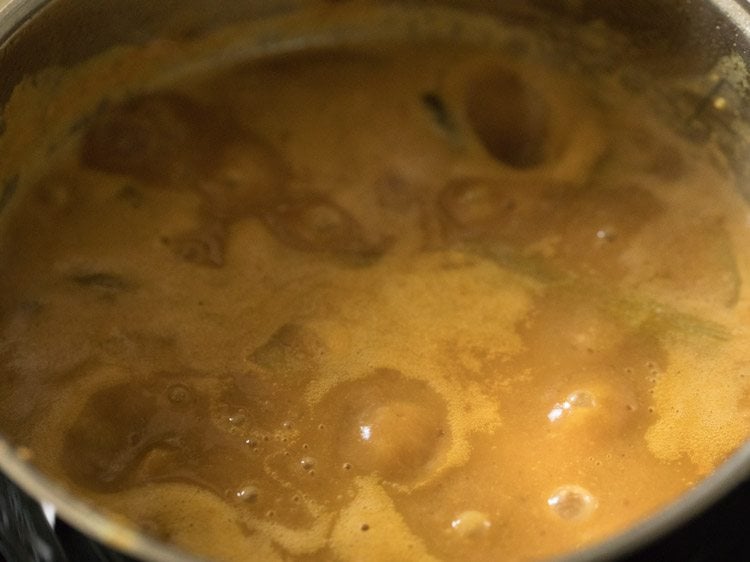
Tempering varutharacha sambar
42. Heat 2 tablespoons coconut oil in a small pan or tadka pan. Add 1 teaspoon mustard seeds.
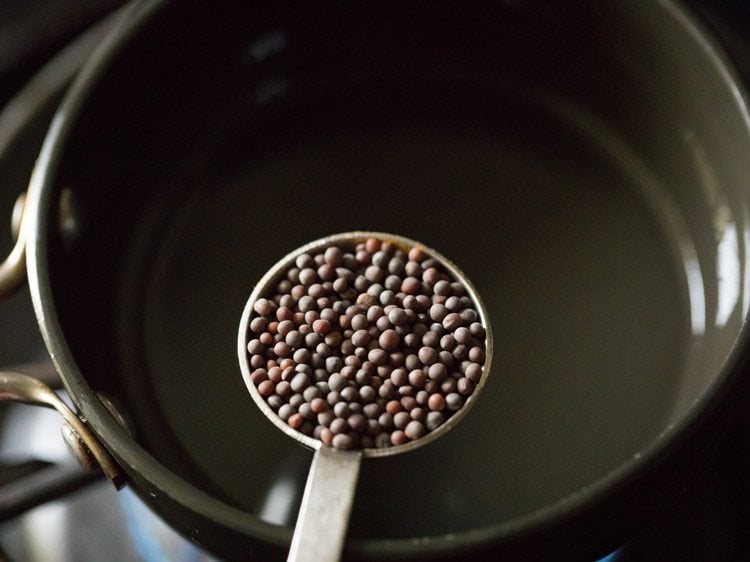
43. Let the mustard seeds crackle.
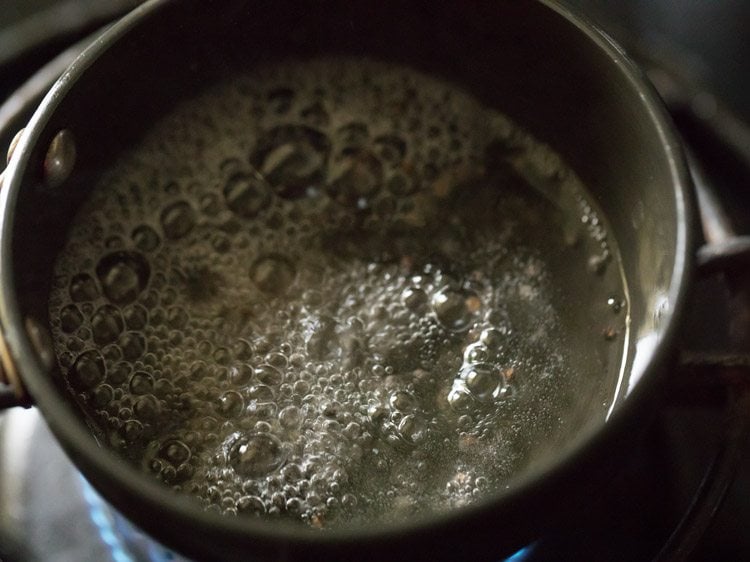
44. Once the mustard seeds crackle, then add 2 dry red chilies and 12 to 15 curry leaves.
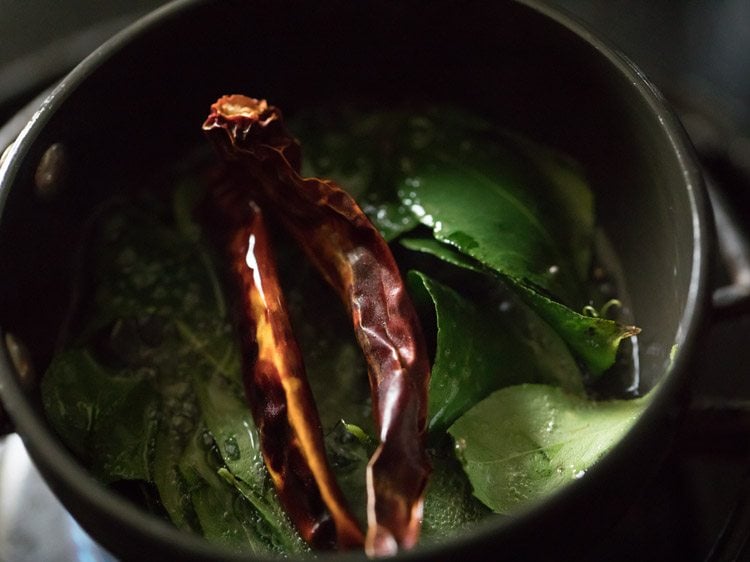
45. Stir and fry till the red chilies change their color.
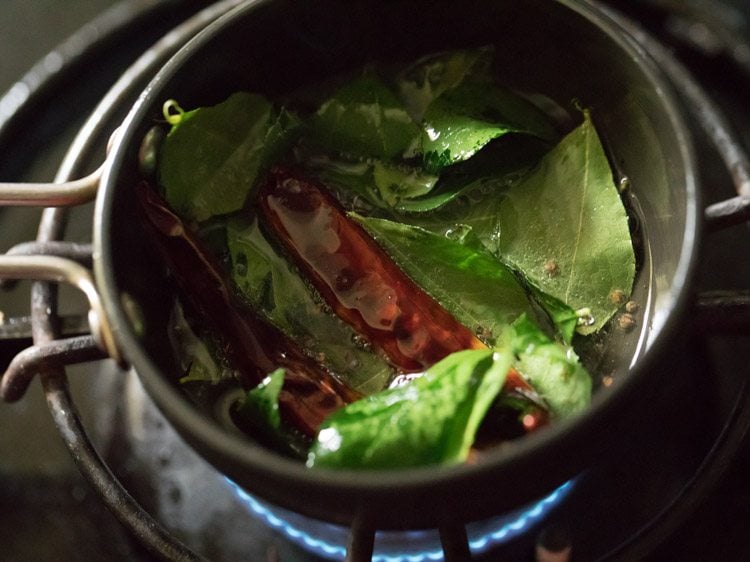
46. Lastly add ⅛ teaspoon asafoetida powder (hing). ⅛ teaspoon is roughly about 2 to 3 pinches.
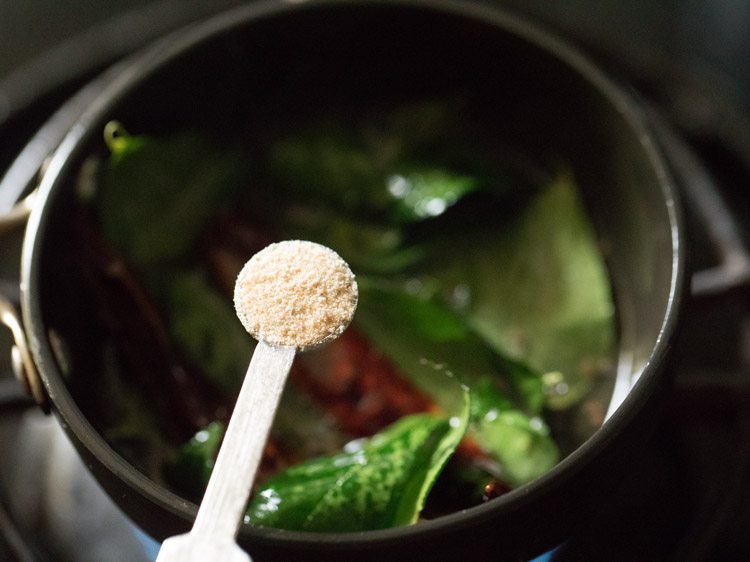
47. Mix and then switch off the heat.
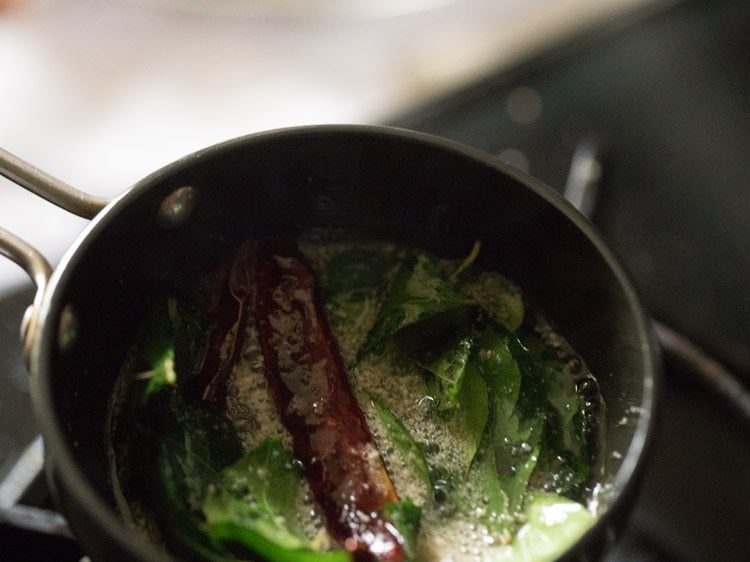
48. Immediately pour the tempering ingredients in the sambar.
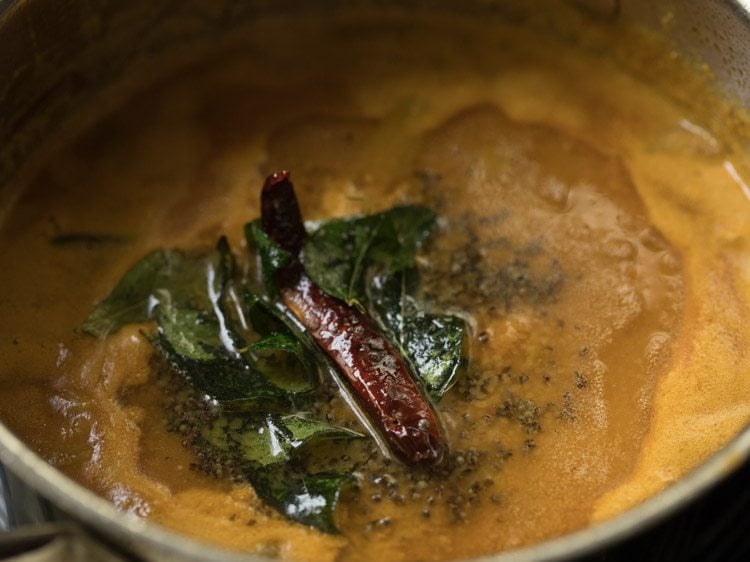
49. Cover and keep aside for some minutes for the flavors to mingle. Then stir and serve varutharacha sambar.
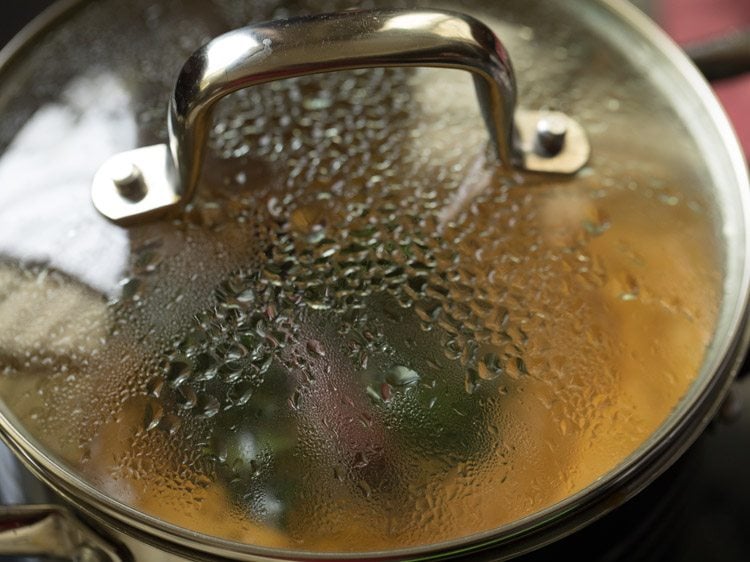
50. Serve varutharacha sambar hot with steamed rice and accompany a thoran and a pachadi by the side. You can also serve it with idli, dosa or uttapam.
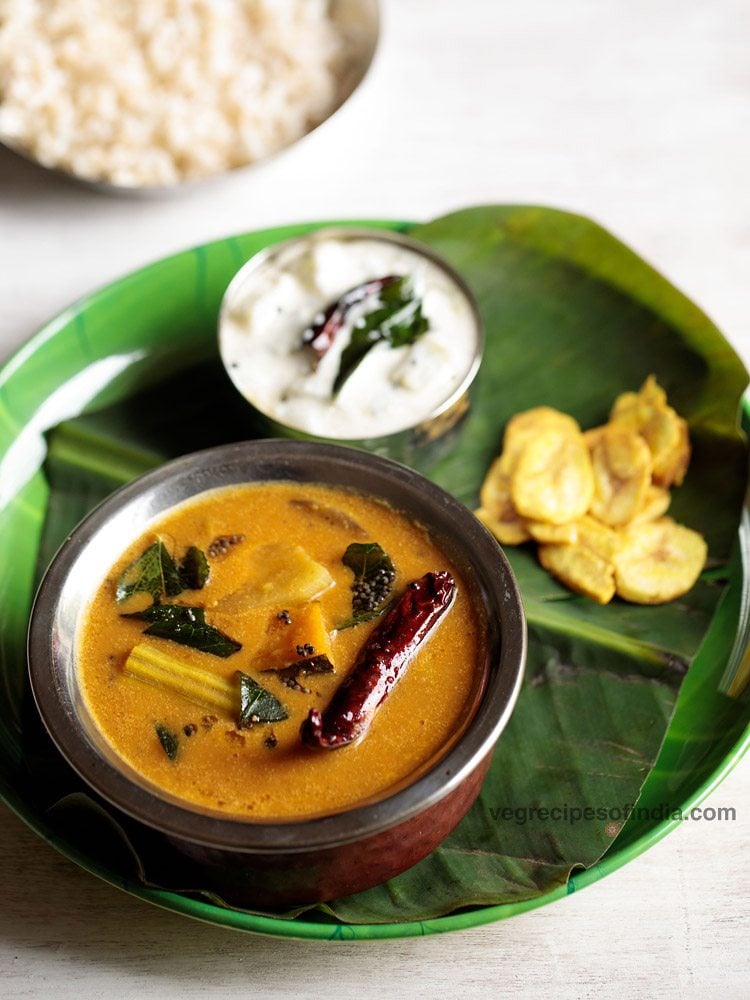
More Sambar varieties
- Idli sambar
- Drumstick sambar
- Sambar – made with mix vegetables
- Pumpkin sambar
- Arachuvitta sambar
Please be sure to rate the recipe in the recipe card or leave a comment below if you have made it. For more vegetarian inspirations, Sign Up for my emails or follow me on Instagram, Youtube, Facebook, Pinterest or Twitter.
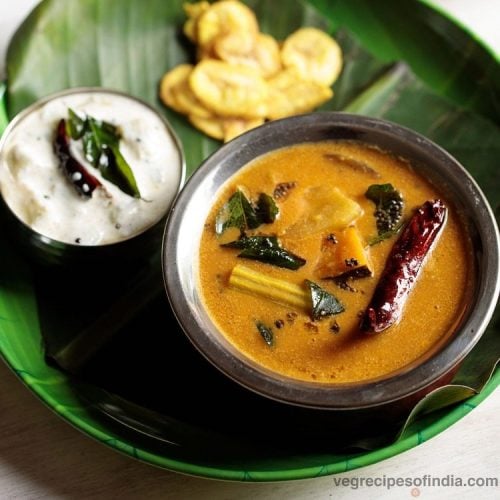
Varutharacha Sambar
Ingredients
for pressure cooking
- ⅓ cup tuvar dal (arhar dal, pigeon pea lentils)
- ¼ teaspoon turmeric powder
- 1.25 cups water
for tamarind pulp
- ½ tablespoon tightly packed tamarind
- ⅓ cup hot water
for cooking veggies
- 1 tablespoon coconut oil
- 7 to 8 pearl onions or shallots (chote pyaaz), optional
- 1 medium tomato or ½ cup diced tomatoes , optional
- 4 to 4.5 cups chopped veggies or
- 1 cup chopped ash gourd
- 1 cup chopped brinjal
- 1 cup chopped pumpkin
- ½ cup drumsticks (saijan ki phali)
- ½ cup snake gourd (chichinda)
- ¼ cup chopped french beans (beans)
- ¼ teaspoon turmeric powder
- 2 cups water for cooking veggies
- salt as required
for making varutharacha sambar masala
- ½ tablespoon coconut oil
- 1 teaspoon chana dal (husked and split bengal gram)
- ½ teaspoon urad dal (husked and split black gram)
- 1 tablespoon coriander seeds
- 4 to 5 dry red chilies
- ¼ teaspoon fenugreek seeds (methi seeds)
- ½ cup fresh grated coconut
- ½ cup water for grinding
for tempering
- 2 tablespoons coconut oil
- 1 teaspoon mustard seeds
- 1 to 2 dry red chilies
- 12 to 15 curry leaves
- ⅛ teaspoon asafoetida powder (hing)
Instructions
pressure cooking dal
- Rinse ⅓ cup tuvar dal a couple of times in water. Add the lentils in a pressure cooker. Add ¼ teaspoon turmeric powder
- Add 1.25 cups water.
- Cover and pressure cook on medium flame for 7 to 8 whistles or for 10 to 11 minutes till the dal becomes mushy and soft.
- When the pressure settles down, open the lid and mash the dal well with a spoon. Cover and keep dal aside.
making tamarind pulp
- Meanwhile when the dal is cooking, soak ½ tablespoon tightly packed tamarind in ⅓ cup hot water. Cover and keep aside for 20 to 30 minutes.
- Later squeeze the pulp from the tamarind and add in the bowl. Keep the tamarind pulp aside.
cooking veggies
- Rinse, peel and chop all the veggies in slightly large pieces. Soak brinjals in water. If using plantains, yam or colocasia, then soak them too in salted water. You can chop the veggies and keep them ready before you cook the dal and make the sambar masala.
- Heat 1 tablespoon coconut oil in a pan.
- Add 7 to 8 pearl onions or shallots and sauté for 1 to 2 minutes on a low to medium flame.
- Then add ½ cup diced tomatoes and sauté for 1 minute.
- Now add 4 to 4.5 cups chopped veggies and saute for a minute.
- Then add ¼ teaspoon turmeric powder and mix well.
- Pour 2 cups water. mix well.
- Add salt as required and mix again.
- Cover and cook veggies till they are tender and done. Do not over cook them. Do check when the veggies are cooking. Cooking veggies on a medium-low flame takes about 20 to 25 minutes.
making varutharacha sambar masala
- When the veggies are cooking, you can make the varutharacha sambar masala. To make the masala, in a small frying pan, heat ½ tablespoon coconut oil.
- Keep the flame to a low and add 1 teaspoon chana dal and ½ teaspoon urad dal.
- Stirring often fry them till they become golden.
- Do stir often for uniform cooking of the dals.
- When the dals have become golden, add 1 tablespoon coriander seeds and mix well.
- Next add 4 to 5 dry red chilies (broken and seeds removed) and mix well.
- Now add ¼ teaspoon methi seeds and again mix.
- Then add ½ cup fresh grated coconut. mix again.
- Stirring non-stop roast the coconut till it becomes golden. Do not burn or over brown the coconut.
- Once the coconut has become golden, remove the pan from fire and keep it down on kitchen countertop. Stir so that the heat gets distributed and the coconut does not roast more. Let this sambar masala mixture become warm or cool down. If the veggies are cooked by this time, then switch off the flame and keep them aside.
- Add the roasted coconut+spices in a grinder jar.
- Add ½ cup water and grind to a smooth paste. Keep aside.
making varutharacha sambar
- The veggies will be done by now. Check them if they are cooked and softened.
- First add the tamarind pulp.
- Then add the mashed dal.
- Next add the sambar masala paste. mix very well.
- Keep the pan on a low to medium flame.
- Simmer sambar till it comes to a boil. Stir at intervals. Then cover and keep sambar aside.
tempering varutharacha sambar
- Heat 2 tablespoons coconut oil in a small pan or tadka pan.
- Add 1 teaspoon mustard seeds and let them crackle.
- Once the mustard seeds crackle, then add 2 dry red chilies and 12 to 15 curry leaves.
- Stir and fry till the red chilies change their color.
- Lastly add ⅛ teaspoon asafoetida powder. Mix and then switch off the flame.
- Immediately pour the tempering ingredients in the sambar.
- Cover and keep aside for some minutes for the flavors to mingle. Then stir and serve the sambar.
- You can serve varutharacha sambar with steamed rice and accompany a thoran and a pachadi by the side.
Nutrition Info (Approximate Values)
This Varutharacha Sambar post from the blog archives first published in September 2017 has been updated and republished on December 2022.
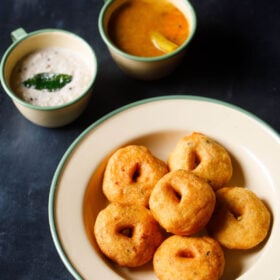
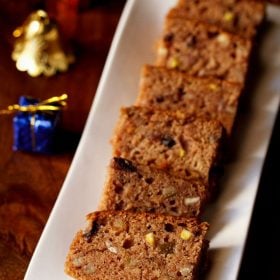
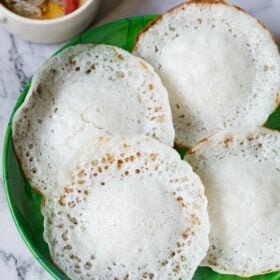
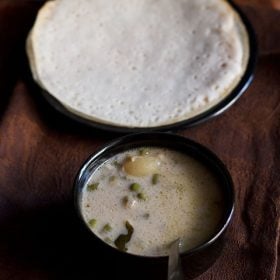








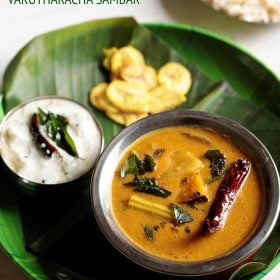
you are my life saver . . i have always cooked every dish from recipe only , as they are not complex and the best . .i have learnt cooking with your recipes only . .thank you for all your help for young people like us . .
Thanks so much Varsha and felt good reading your comment. Thanks once again.